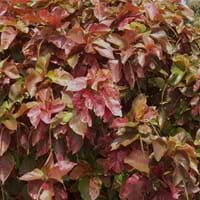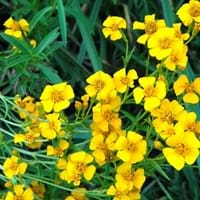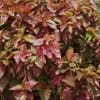Type
Shrub
Flowering Plants, Shrubs
Origin
Melanesia
Mexico, Central America
Types
Not available
African or American Marigolds, French Marigolds, Mule Marigolds
Number of Varieties
Not Available
Habitat
Subtropical climates, Tropical regions
Roadsides, wastelands
USDA Hardiness Zone
10-15
9-11
AHS Heat Zone
12-1
12 - 1
Sunset Zone
H1, H2, 17, 18, 19, 20, 21, 22, 23, 24
A1, A2, A3, H1, H2, 1a, 1b, 2a, 2b, 3a, 3b, 4, 5, 6, 7, 8, 9, 10, 11, 12, 13, 14, 15, 16, 17, 18, 19, 20, 21, 22, 23, 24
Habit
Oval or Rounded
Upright/Erect
Flower Color
Red, Green, Copper
Yellow, Orange, Gold, Ivory
Flower Color Modifier
Not Available
Bicolor
Fruit Color
Not Available
Not Available
Leaf Color in Spring
White, Yellow, Green, Purple, Orange, Chartreuse, Dark Green, Pink, Rose, Burgundy, Copper, Bronze
Dark Green
Leaf Color in Summer
White, Yellow, Green, Purple, Orange, Chartreuse, Dark Green, Pink, Rose, Burgundy, Copper, Bronze
Dark Green
Leaf Color in Fall
White, Yellow, Green, Purple, Orange, Chartreuse, Dark Green, Pink, Rose, Burgundy, Copper, Bronze
Dark Green
Leaf Color in Winter
White, Yellow, Green, Purple, Orange, Dark Green, Pink, Rose, Burgundy, Copper, Bronze
Light Green
Leaf Shape
Reniform
Toothed
Plant Season
Spring, Summer, Fall, Winter
Summer, Fall
Sunlight
Full Sun, Partial Sun, Partial shade
Full Sun
Growth Rate
Fast
Very Fast
Type of Soil
Loam, Sand
Clay, Loam, Sand
The pH of Soil
Acidic, Neutral
Neutral, Alkaline
Soil Drainage
Well drained
Well drained
Bloom Time
Indeterminate
Indeterminate
Tolerances
Drought, Variety of soil types
Drought
Where to Plant?
Ground, Pot
Container, Ground, Pot
How to Plant?
Stem Cutting
Seedlings
Plant Maintenance
Medium
Medium
Watering Requirements
Average Water Needs
Allow to dry out slightly between watering
In Summer
Lots of watering
Lots of watering
In Spring
Moderate
Moderate
In Winter
Average Water
Average Water
Soil pH
Acidic, Neutral
Alkaline, Neutral
Soil Type
Loam, Sand
Clay, Loam, Sand
Soil Drainage Capacity
Well drained
Well drained
Sun Exposure
Full Sun, Partial Sun, Partial shade
Full Sun
Pruning
Remove damaged leaves, Remove dead branches, Remove dead leaves
Prune ocassionally, Remove dead or diseased plant parts, Requires little pruning
Fertilizers
slow-release fertilizers
All-Purpose Liquid Fertilizer
Pests and Diseases
Aphids, Mites, Soft scales
Alternaria Leaf Spot, Bacterial leaf spot, Damping-off, Gray mold, Powdery mildew, Root rot
Plant Tolerance
Drought, Variety of soil types
Drought
Flowers
Insignificant
Showy
Flower Petal Number
Not Available
Single, Double, Semi-Double
Fragrant Bark/Stem
No
Yes
Foliage Texture
Bold
Coarse
Foliage Sheen
Glossy
Matte
Attracts
Birds, Not Available
Butterflies
Allergy
bronchial asthma, Rhinoconjunctivitis
Not Available
Aesthetic Uses
Beautification, Cottage Garden, Showy Purposes
Showy Purposes
Beauty Benefits
Skin Problems
Not Available
Environmental Uses
Air purification
Air purification
Medicinal Uses
Abdominal Disease, Antibacterial, Antifungal, Cough, Headache, Kidney problems
Burns, constipation, Inflammation, Upset stomach, Wounds
Part of Plant Used
Leaves, Twigs
Flowers, Seeds
Other Uses
Basketary, Used as Ornamental plant
Can be made into a herbal tea, Decoration Purposes, Used As Food
Used As Indoor Plant
Yes
Yes
Used As Outdoor Plant
Yes
Yes
Garden Design
Bedding Plant, Container, Feature Plant, Foundation, Hedges, Houseplant, Mixed Border, Tropical
Flower borders
Botanical Name
ACALYPHA wilkesiana
Tagetes lucida
Common Name
Copperleaf
sweetscented marigold, Mexican marigold
In Hindi
Copperleaf
sweetscented marigold
In German
Copperleaf
süß duftend Ringelblume
In French
Copperleaf
Yauhtli
In Spanish
copperleaf
pericón, Santa María, yerbanís
In Greek
Copperleaf
γλυκό άρωμα κατιφέ
In Portuguese
Copperleaf
Tarragon Mexicano
In Polish
CopperLeaf
słodkie pachnące nagietka
In Latin
Copperleaf
sweetscented marigold
Phylum
Magnoliophyta
Tracheophyta
Class
Magnoliopsida
Magnoliopsida
Order
Euphorbiales
Asterales
Family
Euphorbiaceae
Asteraceae
Clade
Angiosperms, Eudicots, Rosids
Not Available
Tribe
Acalypheae
Not Available
Subfamily
Acalyphoideae
Not Available
Season and Care of Copperleaf and Sweetscented Marigold
Season and care of Copperleaf and Sweetscented Marigold is important to know. While considering everything about Copperleaf and Sweetscented Marigold Care, growing season is an essential factor. Copperleaf season is Spring, Summer, Fall and Winter and Sweetscented Marigold season is Spring, Summer, Fall and Winter. The type of soil for Copperleaf is Loam, Sand and for Sweetscented Marigold is Clay, Loam, Sand while the PH of soil for Copperleaf is Acidic, Neutral and for Sweetscented Marigold is Neutral, Alkaline.
Copperleaf and Sweetscented Marigold Physical Information
Copperleaf and Sweetscented Marigold physical information is very important for comparison. Copperleaf height is 240.00 cm and width 180.00 cm whereas Sweetscented Marigold height is 60.00 cm and width 50.00 cm. The color specification of Copperleaf and Sweetscented Marigold are as follows:
Copperleaf flower color: Red, Green and Copper
Copperleaf leaf color: White, Yellow, Green, Purple, Orange, Chartreuse, Dark Green, Pink, Rose, Burgundy, Copper and Bronze
Sweetscented Marigold flower color: Yellow, Orange, Gold and Ivory
- Sweetscented Marigold leaf color: Dark Green
Care of Copperleaf and Sweetscented Marigold
Care of Copperleaf and Sweetscented Marigold include pruning, fertilizers, watering etc. Copperleaf pruning is done Remove damaged leaves, Remove dead branches and Remove dead leaves and Sweetscented Marigold pruning is done Prune ocassionally, Remove dead or diseased plant parts and Requires little pruning. In summer Copperleaf needs Lots of watering and in winter, it needs Average Water. Whereas, in summer Sweetscented Marigold needs Lots of watering and in winter, it needs Average Water.





